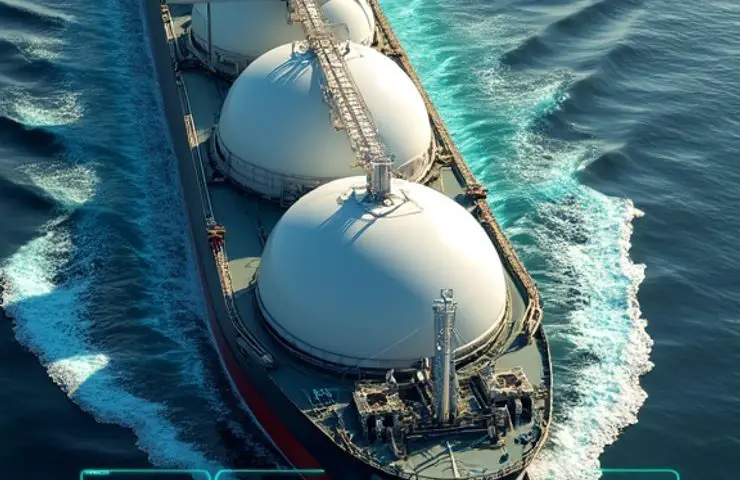Japan Advances Zero-Emission Shipping Technology

Japan has made significant strides in the quest for zero-emission shipping technology, receiving a crucial approval for a new vessel design. On September 8, 2025, ClassNK awarded an Approval in Principle (AiP) for an innovative LPG/ammonia carrier developed by Kawasaki Heavy Industries and Mitsui E&S. This vessel is engineered to operate on clean ammonia, aligning with the International Maritime Organization’s (IMO) stringent emissions regulations aimed at reducing maritime CO₂ emissions.
Revolutionary Vessel Design
The newly approved design features a medium-range LPG carrier with a capacity of 27,000 to 65,000 cubic meters. This vessel will utilize an Ammonia Dual-Fuel Engine, which allows it to draw liquid ammonia directly from its cargo tanks. By eliminating the need for separate fuel tanks, this design maximizes cargo space and simplifies fuel management, which is essential for advancing industrial decarbonization efforts. ClassNK’s approval followed extensive evaluations, including 3D structural analyses and risk assessments, as well as adherence to the 2024 ammonia-fueled ship guidelines.
At the core of this design is the Ammonia Dual-Fuel Engine, which employs electronic fuel injection to optimize ammonia-diesel blends for efficient combustion and reduced nitrogen oxide (NOx) emissions. The vessel is equipped with a robust after-treatment system, including selective catalytic reduction (SCR) and ammonia slip catalysts, ensuring compliance with IMO Tier III emissions standards.
-
- Cryogenic Fuel Supply: The vessel maintains liquid ammonia at -33°C within double-jacketed stainless steel lines, featuring pressure-relief valves and burst discs that direct any venting into scrubber-equipped areas.
-
- Boil-off Management: A closed-loop cold box captures and reliquefies boil-off gas, minimizing fuel loss.
-
- Safety Systems: Continuous gas detectors, automatic isolation valves, and enhanced ventilation are integrated into emergency protocols based on hazard identification (HAZID) assessments.
The materials used for hull plating and piping are specifically chosen to withstand ammonia’s corrosive properties. Crew members will undergo training on leak response, personal protective equipment, and regular system inspections to ensure safe operations.
Strategic Implications for the Shipping Industry
Receiving the AiP marks a pivotal moment for Kawasaki Heavy Industries and Mitsui E&S, as it initiates detailed engineering processes, secures financing, and sets the foundation for construction. Both companies are well-established in the marine and industrial sectors, positioning themselves to capitalize on the emerging multi-billion-dollar market for alternative-fuel vessels.
While the infrastructure for ammonia bunkering is still developing, utilizing cargo tanks for fuel significantly reduces initial costs for shipowners. Analysts predict that with the expansion of bunkering capabilities at ports, ammonia could account for 10-20% of new alternative-fuel ship orders by the early 2030s, propelling sustainable energy initiatives in maritime transport.
Japan’s extensive shipbuilding legacy and its substantial fertilizer industry provide a competitive advantage in ammonia production and fuel applications. Meanwhile, European companies like MAN Energy Solutions and Wärtsilä are testing ammonia engines, and organizations such as DNV GL and ClassNK are working to standardize safety guidelines, indicating that global regulations are on the horizon. South Korean shipyards are also considering retrofitting existing vessels, but Japan’s planned ammonia terminals in Osaka and Nagoya strengthen its position in this evolving market.
Looking ahead, the next steps include finalizing detailed engineering and procurement, followed by sea trials and port tests. If all progresses smoothly, the first ammonia-fueled carriers could be operational by 2028. Concurrently, regulators, ports, and insurers will need to update their guidelines regarding ammonia bunkering, risk assessments, and coverage.
In the long term, ammonia-fueled designs may extend to bulk carriers and tankers, potentially serving as hydrogen transport as ammonia can also function as a hydrogen carrier. While challenges remain in infrastructure and training, this AiP lays a clear path toward a low-carbon future in maritime shipping.
About the Companies
Kawasaki Heavy Industries, established in 1896, is a leading Japanese company specializing in shipbuilding, aerospace, and industrial equipment. Mitsui E&S, part of the historic Mitsui Group, focuses on marine engines and energy systems. Their collaboration highlights Japan’s commitment to industrial decarbonization and sustainable energy solutions in the shipping industry.
